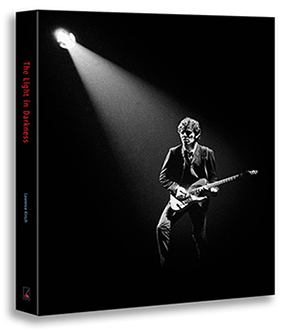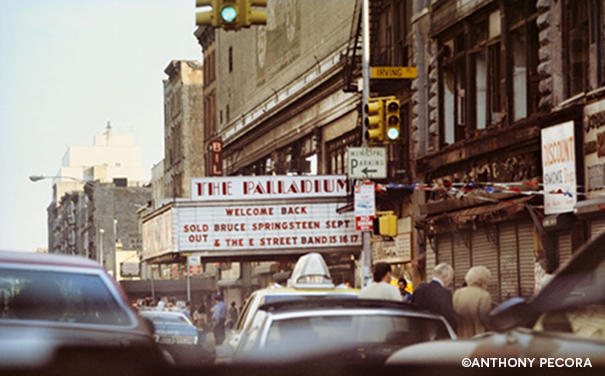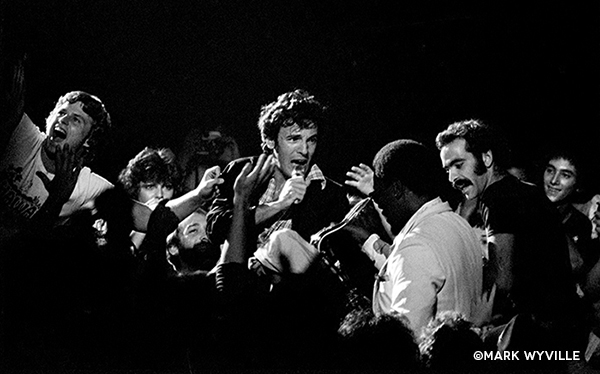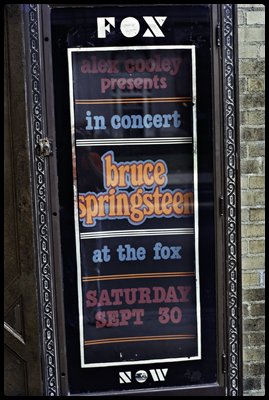Finding The Light in Darkness: A conversation with Springsteen book publisher Lawrence Kirsch
As we break the seal on 2010, I’m looking forward (as so many Springsteen fans are) to the much-discussed commemorative box set for Bruce Springsteen’s classic release, Darkness on the Edge of Town. We don’t know at this point specifically what shows/materials will be incorporated into the bonus elements of the release, but it is allegedly going to hit the shelves this year. If you bought the previous box set for Born to Run, I think you’ll agree with me that this new release will be something to look forward to as a Bruce fan.
My anticipation for the release of this set doubled late last year with the release of The Light in Darkness, Lawrence Kirsch’s excellent chronicle of the Darkness on the Edge of Town tour.

The Light in Darkness
Limited Edition Bruce Springsteen Book
Told from the fan’s perspective, by the fans themselves, Kirsch took the numerous fan story submissions, combined them with over 200+ classic photographs from the tour, and delivered an amazing gift to Bruce fans. With time travel via DeLorean still unlikely, The Light in Darkness is the closest that you’ll ever come to attending a show on the Darkness tour.
After finishing the book (my review is posted here), I had some further questions and wanted take a look under the hood at the assembly process behind releasing something like The Light in Darkness, one that is most certainly mammoth. Kirsch was more than happy to answer a few questions, and I’m glad that I took the time to inquire, because he certainly had plenty to say, and I think that all music fans will enjoy reading the story of how The Light in Darkness (and Kirsch’s previous book For You) moved from a concept to the actual release.
To start off, let’s talk a little bit about your early background professionally – from what I read, you spent about 20+ years as a professional photographer with Springsteen being among the many famous names that you photographed.
I started shooting concerts as a hobby in 1972, The Rolling Stones Exile on Main Street tour was the first concert I photographed. I worked professionally from 1977 (first gig was Elvis Costello for CBS records) until 1989. Since 1972 I have photographed over 300 major rock acts including David Bowie, Bruce Springsteen, Bob Dylan, Eric Clapton, Queen, AC/DC, Pink Floyd, The Ramones, U2, Rush and Elton John.
Based in Montreal, I traveled throughout Canada and the US for photo sessions commissioned by WEA, CBS, Capitol, MCA, RCA and other major record labels. My photographs have appeared in more than 100 magazines, as well as CDs, DVDs, box sets, (including 3 photos in the Springsteen Ties that Bind, River box set) record label web sites, books, posters, concert programs, calendars, wine labels (AC/DC) gallery showings, and on record sleeves.
“I was in the right place at the right time. People ask me how did you choose to be a rock & roll photographer? Well, I never did, really. It chose me. I was attending music concerts since 1970 and wanted to linger on long after the concert was over. So I picked up a camera and starting shooting photographs for friends and myself. In university I met a friend who had connections to CBS Records. She got me an interview and ultimately my first professional gig in 1977.” You can view some of my work here.

For You Stories and Photographs
by Bruce Springsteen’s Legendary Fans.
Limited Edition Bruce Springsteen Book, Sold Out
I just got my hands on For You, your first Springsteen book from a couple of years ago, and it’s amazing. Had you done any other books prior to For You?
I had contributed photographs to quite a few books focusing on different music artists, and came up with the concept for a book on Bruce Springsteen published in England called Bruce Springsteen: Blinded by the Light, but had never worked on a book of my own.
Where did you come up with the idea to do a book about Springsteen, and what kind of legwork was involved in making it happen, legally?
Having attended so many Springsteen concerts since 1975 I kept meeting fans that all had this incredible sense of shared community. Whether I met them in person at concerts, through written correspondence or later via emails, we all had the same thing in common, this undeniable love and appreciation of Bruce Springsteen’s music. What I thought was missing was a touchstone that fans could contribute to and ultimately turn to understand that they were not alone in this passion for this great songwriter and human being.
From a legal perspective I asked everyone that submitted a story to sign a document stating that the text they sent was there own, and that we could use it in the book and for publicity. I also asked all the photographers to sign a photo release form stating the images belonged to them and that they were granting us permission to reproduce them in the Springsteen book For You, Original Stories and Photographs by Bruce Springsteen’s Legendary Fans. Another legal aspect that I was very conscious of was that many fans quoted Bruce’s lyrics in their story submissions and I was not 100% clear on the legality of that. To make certain that we did not break any legal rules I had my editor remove all lyric quotations from the final selected stories. It certainly took away some of the flavour and nuance of the some stories, but I could not take the chance.

From the 1978 Darkness on the Edge of Town tour:
The Palladium, New York, NY ©Anthony Pecora
Your two books are also self-published, assembled with a small team of editors and layout professionals. What are the pros and cons to this approach?
Well, I guess the first and most important benefit to self-publishing is that you have total control; you are the final decision maker. However, I did surround myself with artistic and passionate professionals who helped me produce excellent quality work. I could not have done these two books without the unbelievable generosity of the Springsteen fan community at large. They provided me with fantastic material to work with, original stories, photographs and scans of memorabilia came pouring in, all contributors were interested in making the tribute volumes as great as they could be.
As I found out, even with many of the contributions being offered gratis, self-publishing is a very expensive proposition. Design, editing, scanning and printing are costly tasks that need to be addressed. Especially for the first book For You, which was a hard cover book. But possibly the most difficult and tedious task of the whole experience is the actual distribution of the book. Anyone can print a book, but then you have to sell it and get it into the hands of your buyers.
This is no easy task and I have dealt with at least 4 different methods of shipping both books. Being situated in Canada, my options are considerably less and more expensive then shipping out of the US (yes, this is one of the options I tried) and the time delay is longer. Fans are for the most part forgiving, and I understand their impatience, after all they paid good money for a product they do not take delivery of sometimes up to 9 weeks. But after the book leaves my office the delivery is out of my control, even if I have a tracking number.
What sort of learning experience did you have based on any mistakes that you might have made during the assembly and promotion of For You?
I have to say that the overall learning experience was phenomenal on both books. As I previously mentioned the outpouring of responses from fans was overwhelming.
For For You, I asked for story contributions of no longer than 300 words, on The Light in Darkness I increased that to 400 words, and permitted contributors to include 3-4 lines of lyrics from any one song. I had a clearer more focused idea of the chronological order of the way we were going to sequence the material in the second book.
Both books are unique – in that, the story is told completely from the fan’s perspective – written by the fans, which is a ballsy move. And yet with Springsteen, I’d argue that there’s nobody better to tell the story.
Agreed. The cliché I read many times is “For the fans, by the fans”. But is there a more qualified fan base to write about their hero? Since the very beginning, Bruce’s personal interaction with his fans is legendary, both during his concerts and his down time, when he walks the streets as a normal citizen of where ever he may be.

From the 1978 Darkness on the Edge of Town tour:
The Palladium, New York, NY ©Mark Wyville
Unlike For You, which focuses on Springsteen’s entire career of touring, your new book The Light in Darkness focuses exclusively on the Darkness on the Edge of Town tour. Why Darkness?
The songs on Darkness spoke to me personally. Yes, the mood is darker than previous albums, but not entirely without hope. Darkness on the Edge of Town is pure, energetic rock and roll and one of the best works that Springsteen would create.
Live in concert, The Music, The Music, The Music.

From the 1978 Darkness on the Edge of Town tour:
Philadelphia Spectrum, Philadelphia PA ©Peter Howes
The Darkness tour was distinguished for the now-legendary two-plus hour sound checks, where Springsteen himself would tour the arena while the E Street Band played in order to judge the sound. Much of this practice was no doubt a vestige of his initial reluctance to play hockey arena-sized venues in light of his audience intimacy and sound concerns, but in truth, the sound on that tour was great – it had to be, as the spoken song intros and stories played a major role in that tour’s message. You had to be able to understand what was being said. And there was a lot spoken, in setting up songs and connecting with the audience. Bruce was thankful to be back where he belonged, on stage, and thankful that his loyal audience was there-and he let us know it.
The best way to describe what you felt when the band walked out onto the boards and ripped into the opening number (whether it was ‘Good Rockin’ Tonight’, ‘Summertime Blues’, ‘High School Confidential’, or ‘Badlands’) is to harken back to the old Maxell tape ads, where the guy puts a Maxell tape into his stereo and the sound that comes out of the speakers blows his hair and his scarf back, and sends his drink skidding across the table through the sheer force and power of its volume and energy. Much has been written and said over the years about the sense of desperation and emotion driving Springsteen on that tour – it’s all true, and then some. Trying to explain it can sometimes seem as daunting a prospect as the challenge put forth by John Sebastian in the Lovin’ Spoonful’s “Do You Believe in Magic?” in that “It’s like trying to tell a stranger about rock and roll.” Bruce and the E Street Band, compared to now, played fast. And they played loud. Not “The Who loud”, but loud enough to trash your ears for a day after the show, regardless of your rock show-going experience. The opening set was heavy on Darknessalbum material, and the songs were augmented, enhanced, and accessorized in a way that doesn’t happen these days. The organ/piano intro to the title track, the extended harmonica/piano intro to ‘Promised Land’, the now-legendary piano/guitar intro to ‘Prove It All Night’, the extended piano coda to ‘Racing in the Street’, the ‘Not Fade Away’/'Mona’/'Gloria’ lead-in to ‘She’s the One’, along with the instrumental break in the middle of it – these flourishes made the songs even more special, and these types of reworking’s are not seen much anymore. By the time ‘Jungleland’ closed the first set, some first-timers in the crowd thought the show was over, such was the quality and quantity of what was delivered in just the opening set!

From the 1978 Darkness on the Edge of Town tour:
Providence Civic Center, Providence RI ©Peter Howes

From the 1978 Darkness on the Edge of Town tour: Fox Theater poster, Atlanta, GA
Live FM broadcast simulcast by about twenty radio stations throughout the south-eastern United States.
The Darkness tour also marked the last time many would get to see The Boss in small concert halls, as Bruce’s exploding popularity forced him to trade up to hockey arenas during several stops on the tour. Stadiums would soon follow. Today, many fans lucky enough to have attended the Darkness tour are glad they did whatever it took to land a ticket, a memory they can still cherish as they now watch Bruce from the nosebleeds. As many fans have noted, a Springsteen concert is something akin to a big tent revival meeting: the energy, the enthusiasm, and most importantly, the healing.
Many performers can entertain a crowd, and put on a great show. But at a Bruce show, he doesn’t just entertain, he brings the audience together. Those around you aren’t just strangers in the seats, they become family, if only for a few hours.
On the way out the concert hall, theater or arena, one was left with an uncanny mix of exhaustion and exhilaration that comes at the end of a Springsteen concert, a feeling that comes because the marathon shows both drained you entirely of energy, while somehow also replenishing with a new strength. In both books that I worked on, fans struggled to describe what this feels like, and how the feeling differs from all the other rock concerts they’ve been too. I don’t pretend to have an explanation. But at best, what I can offer is that through some strange magic, Bruce, in his pure enthusiasm for what he does, and his unpretentious ability to connect with a crowd, he was able to elevate that mass of people from a mere rock and roll crowd into a rock and roll community.
As fan Lou Carlozo wrote:
“But Bruce – a bus driver’s son wielding all the determination of a blue-collar man sweating to the last paycheck dime – shared his best with his fans again and again and again. Is it any wonder, then, that magic permeates every Bruce Springsteen concert and touches the people who pack his shows to capacity? Yes, Bruce was one of us: The only real difference was that he wrote and sang amazing songs, though he thrived whenever we joined him and sang along. He fed us, we fed him back. The circle was joined. And it remains unbroken.

From the 1978 Darkness on the Edge of Town tour:
Augusta Civic Center, Augusta ME ©Lawrence Kirsch
As a fan, you had the dream ticket being in attendance for the opening night of the Darkness tour.

Shea’s Buffalo Theatre, Buffalo, NY
I had first witnessed Bruce in concert in Montreal, December 1975 on the Born to Run Tour. I saw it with my cousin from New York. After that, Bruce disappeared, at least for me, with no new album and no concert dates in my area for three years. So when I received a call from the same cousin now living in Buffalo to attend Bruce’s premiere show to showcase his new album, I was psyched.
I was there when Bruce broke out of creative jail. The night Bruce was able to perform new songs how and when he wanted to. What I remember most was the raw emotion that Bruce presented on stage. I would even say he was a bit nervous and tentative. But by the time he launched into “Something in the Night” and screamed so his body shook, we knew he was going to take no prisoners, even if it killed him, and us. I had been anticipating this show for close the three years. The audience and atmosphere were electric, we had no idea what to expect, as the new album Darkness on The Edge of Town had not been released yet. I remember the thick smell of marijuana when I walked into the grand old Shea theater, and the humid heat of the air. I remember superfan Obie and photographer/girlfriend Lynn Goldsmith hanging out in the first row waiting with anticipation like the rest of us for the lights to go down.
And then it started.
How many shows did you end up seeing on the Darkness tour?
I saw nine shows on the tour, including the opening show in Buffalo and the last two in Cleveland. I have photos I took from six of the shows reproduced in The Light in Darkness.
How did you first come across Springsteen’s music, and what is that moment that you can point to that officially made you a fan?
I discovered Bruce’s first two albums in 1974 by hearing them on the radio. I liked the albums, can’t say I loved them.
The defining moment for me was December 19, 1975 when I saw Bruce in an 800 seat theatre in Montreal.
What do you remember about your first Springsteen show?
I remember that the night was freezing and that Bruce commented on the temperature during the show, more than once. He wore his customary wool hat on stage and unbelievably he would fling it at his mike stand from various locations on the stage and nail it on the stand!
I remember having tickets in the balcony and feeling that Bruce was playing to us all night. Oh yeah, and I remember the music. I remember Bruce coming on stage in the dark to start the show, one blue spotlight on Roy Bittan while he played the introduction to Thunder Road. I had seen and photographed many shows before then, but nothing as dramatic as that. His interaction with the audience, the stories, and the musicianship all were new experiences for me.
It’s often hard for a non-Springsteen fan to understand the typical Springsteen fanaticism – How many Springsteen gigs have you been to over the years, and what is it that keeps you coming back for more?
I don’t really feel compelled to try to convince anyone to see a Bruce Springsteen concert. Many music fans in my hometown do not appreciate him, and I can understand that. I have seen close to ninety shows, which amazes me to this day. But whenever I think that this is a large number, I think about fans that have season tickets to baseball, basketball or hockey teams-how many games do they see a year, year after year? It is all about the passion, the passion of the music and sharing it with 10,000, 20,000 or 50,000 like-minded fans.

From the 1978 Darkness on the Edge of Town tour: Cleveland Coliseum, Cleveland OH
©Anastasia Pantsios
Have you gotten any reaction from the Springsteen camp about the books?
When I launched the first book, For You, I had met Bruce’s security person in Boston in November of 2007 and had given him a book to show to Bruce. It was returned to me about a month later from Denmark, signed.
Then Bruce announced a concert in my home city of Montreal. From the time I got the call around 6.20 Sunday night, March 2, until 23 seconds before Bruce took the stage, I was backstage. Along with Humphrey Kadaner president of HMV Canada, I was the personal guest of Bruce’s co-managers in their Bell Center suite. There we were offered wine and cheese in a very relaxing atmosphere. Prior to this I had to go through 2 security checks and have 2 wrist bands applied, a backstage pass and given a ticket to the “pit” area. I chatted to Bruce’s managers for close to 90 minutes and during that time was given a handwritten set list for the Montreal show…
And then it happened, I met Bruce. We chatted; I presented him a copy of the book and told him it was on behalf of his fans worldwide who appreciate his great music and the enjoyment he has brought to us over all these years. He signed a copy of the book for me. While all of this was going on Miami Steve and one or 2 other E-Streeters were rehearsing the harmonies on “Because the Night” a capella not 10 feet away. Bruce posed for photos with me, and then I walked with him as he joined the other members of the E-Street band literally 23 seconds before he took the stage. Then I took my spot in the pit and had the time of my life.
Like the first book, The Light in Darkness also is a limited pressing of 2400 copies – What’s the next project on tap for you after this one is done?
Well, I am contemplating several ideas for books right now.
Subjects include The Rolling Stones, David Bowie and a book on meal planning for vegetarians. Also, a short story written by a Springsteen fan that grew up in Bruce’s neighbourhood and came in contact with several of the same people he did on a daily basis. He spent some time with Bruce; the time period covers the early 1970’s to around 1976/1977.
Of course if this becomes a reality it will have some classic never seen before photos. I know if fans had their way they would like to see a book on The River. I don’t think that is in the cards for me, but never say never.
Thanks to Lawrence for a great interview!
The Light in Darkness was a limited edition printing of only 2400 copies, and is now sold out. Thanks to the Springsteen fan community for all your support, without you the book could never have seen the light of day. all the best,
Lawrence Kirsch
The Light in Darkness
Matt Wardlaw
Matt grew up in the 80’s in Odessa, Texas – home of prairie dogs, Permian Panthers football (as covered in the movie Friday Night Lights,) oil wells, and not much else. The remainder of my time growing up was spent in the mountains of New Mexico which led to my family moving to the Chicago area suburb of Joliet, and finally in 1989 we made our final move to Cleveland, OH. An early life spent living in small towns and cold weather left me plenty of time for listening to as much music as I could get my hands on.






